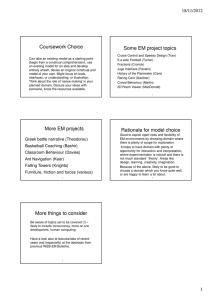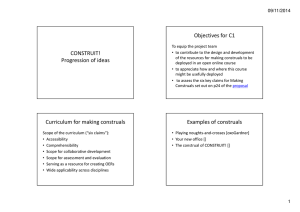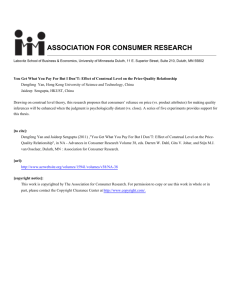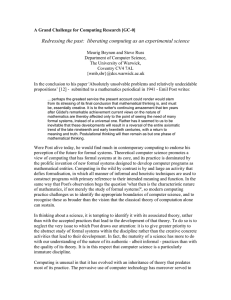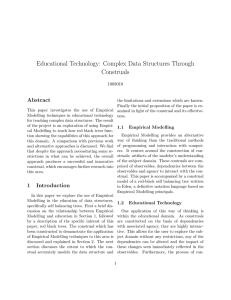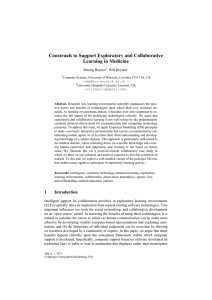in format
advertisement
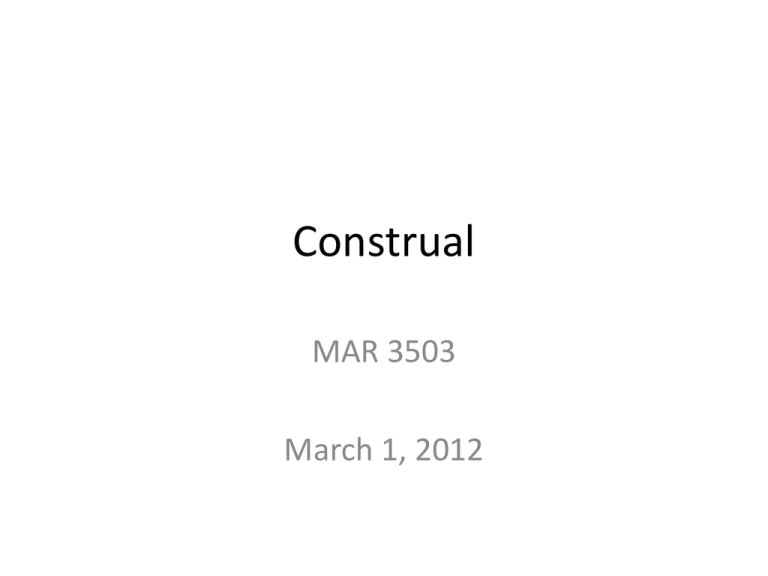
Construal MAR 3503 March 1, 2012 False consensus effect Estimated percent of others who would: Rater’s own choice Ross, Greene, & House, 1977 Construal • The way in which a person interprets the world around them • The same situation may produce very different behavior depending on the subjective meaning that is attached to it • This is a fundamental theme in the study of consumer behavior! Some determinants of construal • 1. Recency Some determinants of construal • 1. Recency • 2. Frequency/familiarity – How would “They ran into the bank” be interpreted by a banker? A sailor? Some determinants of construal • 1. Recency • 2. Frequency/familiarity • 3. Context Primacy effects in judgment Person A is… • Intelligent • Industrious • Impulsive • Stubborn • Critical • Envious Person B is… • Envious • Critical • Stubborn • Impulsive • Industrious • Intelligent A treat • It’s hot, and you’re at the beach. You want a refreshment. How much would you pay for this Häagen Dazs ice cream? Reactive devaluation • Proposal offered by the Palestinians on 5/10/93 • “How good is the proposal for Israel (1-7)?” minus “How good is the proposal for the Palestinians (1-7)? Putative source Participants Israeli delegation Palestinian delegation Israeli Jews -0.95 -2.45 Israeli Arabs 0.93 -0.01 Party over policy • Participants evaluate a welfare reform bill – Some participants were told that the bill was written by Republicans, others told it was written by Democrats • Ps indicate (on a 1-7 scale) how much they are in favor of the bill Bill was written by Participants’ own affiliation Liberal Conservative Democrats 5.46 2.69 Republicans 3.15 5.49 Cohen, 2003 Some determinants of construal • • • • 1. Recency 2. Frequency/familiarity 3. Context 4. Motivation Construal and above average effect • “…Everyone ranks himself high in qualities he values; careful drivers give weight to care, skillful drivers give weight to skill, and those who think that, whatever else they are not, at least they are polite, give weight to courtesy, and come out high on their own scale. This is the way that every child has the best dog on the block.” –Thomas Schelling Construal and above average effect • Dunning, Meyerowitz, & Holzberg (1989) • More of an above average effect on ambiguous traits (e.g., sensible) than unambiguous traits (e.g., punctual) • Less of an above average effect when asked to make ratings based on specific criteria supplied by someone else Some determinants of construal • • • • • 1. Recency 2. Frequency/familiarity 3. Context 4. Motivation 5. Temporal perspective Construal level Being social awkward OR Standing alone Achieving a goal OR Wearing a medal Being a voter OR Going to the polls Temporal construal theory • People adopt higher level construals when considering distant as opposed to near future events High-level construals Low-level construals Abstract Concrete Simple Complex Structured, coherent Unstructured, incoherent Decontextualized Contextualized Primary, core Secondary, surface Superordinate Subordinate Temporally distant = higher level • When people are asked to list events they expect to experience during a good day or bad day in the near or distant future: – The near-future events are more variable in valence (SD of ratings) – The distant-future events are more extreme in valence (mean ratings) • People are more likely to code near-future events in terms of “how” and distant-future events in terms of “why” – Does “locking the door” mean “putting a key in the lock” or “securing the house”? Temporal construal theory • Implications for preference, choice, and behavior: • “Getting away from it all” versus “buying food, assembling gear, getting permits, etc.” • “Cheating on an exam” versus “peeking at my neighbor’s exam to compare answers” The big message • The broader message of construals is that we may think that our memories, feelings, and knowledge are set and reflect reality, but… • Instead, our knowledge and preferences are constructed What is reframing? • It’s presenting the same option in different formats – This can change people’s opinions, choices, and preferences – Both formats are accurate, and convey the same information – The meaning of that information is what differs • REFRAMING: “Our new fan uses 50% less energy than our old fan!” versus “Our old fan uses twice as much energy as our new fan!” • NOT REFRAMING: “Our new fan uses 50% less energy than our old fan!” versus “Our new fan uses twice as much energy as our old fan!” Framing effects • • • • Pro-life versus pro-choice Liberal versus progressive Terrorists versus freedom fighters Cash discounts versus credit card surcharges Framing effects • Imagine that the country is preparing for the outbreak of an unusual disease, which is expected to kill 600 people. Two programs have been proposed. – If program A is adopted, 200 people will be saved – If program B is adopted, there is a 1/3 chance that 600 people will be saved, and a 2/3 chance that no one will be saved • Imagine that the country… – If program C is adopted, 400 people will die – If program D is adopted, there is a 1/3 chance that nobody will die, and a 2/3 chance that 600 will die Tversky & Kahneman, 1981 Prospect theory • People are risk averse when choosing among gains, and risk seeking when choosing among losses • Loss aversion: losses loom larger than gains – Consider a gamble where you have a 50% chance of winning $1000 and a 50% chance of losing $1000 – Gains often need to be twice as big as losses for people to be willing to take the bet Prospect theory Mental accounting • Imagine that you have decided to see a play and paid the admission price of $20 per ticket. As you enter the theater, you discover that you have lost the ticket. The seat was not marked and the ticket cannot be recovered. • Would you pay $20 for another ticket? Tversky & Kahneman, 1984 Mental accounting • Imagine that you have decided to see a play where admission is $20 per ticket. As you enter the theater, you discover that you have lost a $20 bill • Would you still pay $20 for a ticket to the play? Tversky & Kahneman, 1984 Mental accounting • Why are people generally willing to buy a ticket after having lost $20, but not willing to buy another ticket after having lost their previous ($20) ticket? • It matters what “mental account” you file the loss under: • If you lose the ticket and buy another, you have just increased the price of the play to $40 • But if you lose $20 and then buy a ticket, the price of the play is still only $20 Sunk costs • Imagine that you and a loved one have paid $50 for two seats to the theater for tonight’s show. You were really looking forward to seeing it, but are not in the mood to go tonight. You’re feeling tired because you didn’t sleep well last night, and thunderstorms are predicted for tonight. You really want to spend the evening on the couch, cozy and warm. What would you do in this situation? Sunk costs • Imagine you spent $500 on a ski trip to Michigan that promises to be pretty fun • Then you find a great deal for a $250 ski trip to Wisconsin, which should be awesome • But after you spend the money, it turns out the two trips overlap, and you can’t get your money back for either, due to the special deal • Which trip do you go on? Arkes & Blumer, 1985 Sunk costs • Sunk costs are payments, investments or costs that can’t be recovered – With the sunk cost fallacy, people treat sunk costs as if they weren’t sunk, but instead they could still “get their money’s worth” • This leads them to: – Clean their plates even when they’re full – Complete costly and unwanted public works projects – Persevere in wars and conflicts so soldiers “won’t have died in vain” Reason-based choice • Why do some people who would grant Parent B custody also choose to deny Parent B custody? • People need to have reasons for their choices, and mixed bag options usually provide more reasons both in favor of an against that option – So which way a person chooses in these kinds of situations is very much influenced by what question they are trying to answer Construal and health • Ps were 84 housekeepers from a variety of hotels in the Boston area, recruited for a study on how to increase health and happiness in the hotel industry • Half were told that their work constituted exercise, half were not • The amount of exercise they got and a number of markers of health were measured • Four weeks after the initial recruitment, they were re-interviewed and re-examined Crum & Langer, 2007 Crum & Langer, 2007 Overarching lesson • It is not the objective situation that is so powerful in determining thought and behavior, it is the subjective situation – it is how people interpret the world that matters • So next time you see choices or behavior that surprise you, think about what situation the person thought he/she was confronting Summary • Construal influences our preferences, perception, and satisfaction • Several determinants of construal – Recency – Frequency/familiarity – Context – Motivation – Temporal perspective Next time… • Predicting preferences and satisfaction
